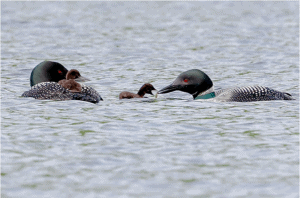By Emma Cotton/VTDigger
These days, birds are susceptible to a scourge of threats — pests, diseases, habitat loss and climate change among them. Still, one species has been thriving in Vermont: the common loon.
This summer, across the state, more loons laid eggs than ever before. In 1983, seven pairs made nests in Vermont. This year, that number climbed to 109. Of those, 77 pairs raised a total of 125 chicks, 85 of which have survived.
The previous record, set in 2019, was 101 nests.
“It’s truly a success story,” said Eric Hanson, a biologist with the Vermont Loon Conservation Project, a collaboration between Vermont Center for Ecostudies and Vermont Fish & Wildlife Department.
Hanson manages around 300 volunteers from across the state, all of whom report nest activity. He said six new pairs nested for the first time this year.

A chick feeds on Silver Lake in Salisbury in 2021.
“That was a big jump,” he said. “We rarely ever see that many new pairs sneak in.”
Loons appeared on lakes where they’ve never been seen before or haven’t been seen in a long time, Hanson said. In southwestern Vermont, nests appeared on Glen Lake and Sunset Lake. In other spots, parents that have tried nesting for years were finally successful.
“One would be Fairfield Pond, which is a fairly large lake,” Hanson said. “The parents have been there for 10 years. They’ve tried nesting five times, and this is the first year they’ve ever had chicks.”
Loons are monogamous creatures, though they typically switch partners several times throughout their relatively long lives, which usually last between 20 and 30 years. Chicks head to the ocean for several years, returning between the ages of 4 and 6 years old. Then, they’ll embark on a several-year search for a spot to nest, usually within 25 to 40 miles of the lake where they hatched.
Vermont removed loons from its endangered species list in 2005. Historically, they’ve been affected by a number of factors: habitat encroachment by humans, competition with other species and fishing gear, which can cause entanglement and lead poisoning.
Flooding can also harm loons’ nesting success. Rising waters can sometimes submerge nests located several inches from the shoreline. To address that, Hanson said he and volunteers have encouraged birds to nest on “bird rafts,” which they construct and float on the water. The rafts also give birds extra habitat, and he thinks they’ve increased loons’ success over the years.
Statewide legislation has also restricted the type of lead fishing gear that is used, which has helped, too, Hanson said.
The Vermont Center for Ecostudies recently received a $400,000 grant from a settlement that followed the 2003 Bouchard B-120 oil spill, which took place in Rhode Island and Massachusetts and killed 500 wintering loons. The center plans to use that money to start a lead buy-back program next summer.
Despite their success, loons are still susceptible to a number of environmental and human-caused threats. Survival rate of chicks decreased this year, Hanson said. That’s likely due to a combination of factors, including predation by snapping turtles and eagles, whose population has also recently rebounded from historically low numbers.
“I expect both eagles and competition to start slowing population growth over the next decade,” Hanson said.
He wonders how changes to the food web, caused by increasingly warmer waters, might affect the birds. Loons’ vulnerability to flooding also adds the birds to a long list of species whose populations will likely be impacted by climate change.
Right now, lead poisoning and entanglement from fishing gear are likely the leading causes of death for loons, Hanson said. Fishers should reel in their line if they see a loon diving nearby, he said, and pick up any discarded line whenever possible. It’s also important to leave nests undisturbed and honor warning signs.
Still, Hanson is encouraged by the high number of new parents that nested throughout the state. He said the deaths that have occurred have had a small impact on the birds’ total population.
“We’ve got six new pairs, and they’re on lakes where they’ve never been before,” he said. “They’re doing really, really well.”




